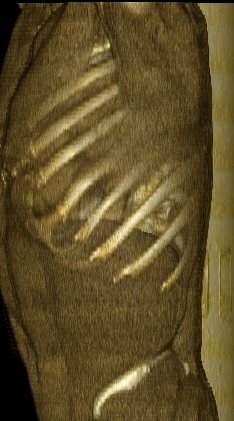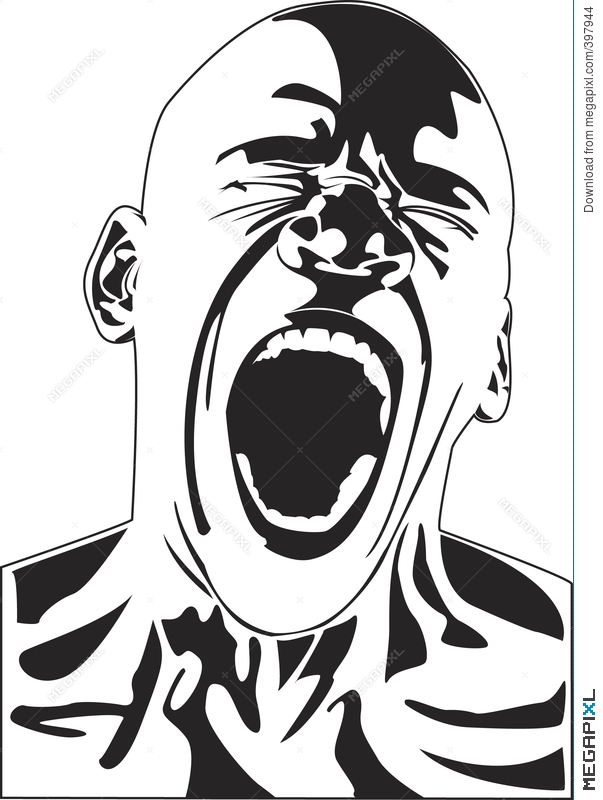
These are my ribs, rendered from a 2022 CT scan. It looks like my 10th rib is basically floating and I suspect the cartilage is also broken above the 9th rib. I can pull both of them out from under the costal margin with loud clicks using the hooking maneuver.
In February 2025 I figured it out and it has since been verified by a radiologist with the only scan that is capable of detecting my condition – a dynamic ultrasound. What is my condition? What is it that turned my life upside down 15 years ago? I believe it is something called Slipping Rib Syndrome. The medical term is interchondral subluxation. It is often associated with Ehlers-Danlos Syndrome (EDS) and trauma to the ribs (which I had plenty of).
So why the back pain? The best explanation is from Dr. Hansen himself and why I think I need to just let him do his thing when I see him August 12th. I could come up with my own theories (below) but I when in doubt, I just need to watch this.
My first suspect is the left 10th costotransverse joint. It is extremely sensitive to palpation about 1/2″ left of the spinous process and it is one of the two joints that the rib uses to articulate into the spine. Mid-back pain is a very common symptom of Slipping Rib Syndrome and I need to find out why. I suspect the subluxed 10th rib tip has pushed the rib out of alignment or is putting pressure on the rib which irritates the costotransverse joint. The costovertebral joint is probably involved too. A PET scan shows excess uptake at both joints from T4 to T12.
My second suspect is the intercostal nerve. Actually that may be my first suspect. It is the the most common nerve irritated by SRS. However, it’s the “knife in my back” that has shut me down and that seems to be the location of the costotransverse joint.
My third suspect is muscle soreness. Dr. Hansen talks about it “activating” all the muscles in the area. It may not be joints or nerves but muscle soreness. Here is a a good article on how SRS causes back pain. The delayed nature of my pain would support the muscle theory. I need to strengthen my core without irritating it.
Then there’s the rotten spine / autoimmune theory. Dr. Biswald (sp?) was pretty sure the vertebral marrow was a major pain generator. He says he sees it with autoimmune illness which I supposedly have. However that’s a cart before the horse thing. I wouldn’t be surprised if my aortic issues indicating GCA weren’t just inflammation from SRS. Seems everything in my thoracic region is a wreck, least of all the core muscles with my herniated and twice repaired ab. What if THAT is what’s causing my back pain. It’s all in the 10th dermatome, my hernia, back pain, SRS… and I have more than one condition in that area.
It’s all very confusing.
What if I have SRS but it’s not what’s causing the knife in my back?
This is my biggest concern. What are the alternatives?
- Facet Joint Syndrome – I did rush into a Z-joint nerve ablation at T9/10 or T10/11 out of desperation many years ago (with mixed results). Check this out! Could this be causing the knife in my back?
- I blew a hole through the middle of my rectus abdominis around 2000. I got surgery in 2003 but because it was a clean tear through the middle of the muscle, the surgeon just stitched it up. I proceeded to rib those stitches out almost immediately with windsurfing in the Columbia River Gorge. I had surgery again in 2019 which revealed significant, long-term damage requiring mesh and diastasis repair. So my left core muscles have been through hell and are still sore. Could this be causing the knife in my back?
- A Stanford radiologist who specializes in imaging for pain did an experimental scan on me using a different radiotracer, FTC, but one that behaves very similar to FDG. This showed a number of osseous issues, suggesting an auto-immune illness. Namely abnormal uptake in the vertebral marrow of T9-12 and the costotransverse/costovertebral joints. He felt the vertebral uptake was a significant pain generator. What if my autoimmune illness is causing the knife in my back?
This costal cartilage reconstruction surgery, while called minimally invasive, is no joke. It’s a long, painful recovery and my nerves are already on fire. I suppose I’m desperate enough to try anything but I hope this is a light at the end of the tunnel and not an oncoming train.
A study suggesting a weak/damaged rectus abdominis connection means my blown out left ab muscle could be connected as well. Unfortunately my story goes back 30 years and includes a lot of physical damage, making a complete understanding of everything almost impossible.
Evidence
Hooking Maneuver: Positive
When performing the hooking maneuver, the 10th rib appears to be folded under the ninth rib. Pulling downward and outward (feels like unfolding), the 10th rib can be pulled back into place with an audible thud that can be heard across the room as well as felt by the practitioner as well as the patient. This triggers a familiar pain in the flank that radiates to the two primary pain locations in the front and back (i.e. it recreates “the Pain”). When the hook is released the rib immediately subluxates (i.e. folds back under the ninth rib). I believe my 9th rib is subluxed as well. I may even have a broken cartilage fragment floating around. I expect Dr. Hansen will find multiple problems when I see him August 12th.
MO
- Easily and definitively diagnosed with hooking maneuver (patient tested strong positive)
- Most commonly affects the 10th rib (the knife in my back is left of my 10th vertebrae)
- Would explain why it has remained undiagnosed for 15 years (this is a rare/underdiagnosed condition)
- Cannot be seen with x-rays, CT, MRI or standard ultrasound. Requires dynamic ultrasound
- Refers pain to the intercostal nerve root between the 9th and 10th vertebrae, exacerbated by pushing on the end of the left transverse process (easily located with Nerve Finder (patent pending))
- The condition often accompanies a history of physical trauma.2 (my ribs have been a piñata, slamming into windsurfing booms for decades, not to mention many other traumatic injuries to my ribcage including mountain biking, snowboarding and numerous watersports). It is a common injury for windsurfers and big-wave surfers.
- The condition is known to accompany hypermobility (the patient is hypermobile)
- It refers to both the mid-back and the chest (same for patient)
- It comes and goes but comes on sharp and stabbing and fades to aching (same for patient)
My Story
I have been in severe, chronic pain for 14 years. Prior to 2010 when it began, I lived with pain as an extreme sports athlete, constantly injured from surfing, windsurfing, snowboarding, mountain biking, motocross and other sports. However the pain that I’ve been battling for over a decade is on a whole other level, more severe than anything I could have imagined before. The pain is constant and wavers between level 3 and level 10. Trying to get help from the US medical system has been a nightmare. I am a disabled engineer. I had to stop working in 2011 because the pain was so severe I couldn’t think straight. It hurt too much to eat. I lost so much weight people were concerned I was dying. In truth I was. I was screaming inside, but nobody was listening. This was before the DEA’s war on pain patients so I was able to get opiates, but even fentanyl patches didn’t relieve the pain. Thankfully I’ve learned to manage it with the help of a doctor who puts her patients first, who still has some empathy and is willing to prescribe methadone, a drug known to be very effective for nerve pain at a low dose. Most doctors won’t do this for their patients and many patients are suffering needlessly and even committing suicide. I do plan to battle this politically once I get my own case under control.
Every day for 14 years, I have been trying to figure out what is hurting me; what is causing the knife in my back just left of my 10th vertebrae? Or the spear that goes all the way through to my xiphoid process. What is the unknown thing inside me that has ruined my life, that is so painful you can see the inflammation all over my left mid-back with the naked eye?
Mystery Solved?!
I think I finally figured it out on my own. I believe my 9th intercostal nerve (left) is being irritated by a subluxated 10th rib, much like in the photo above (actually the photo shows the 7th intercostal nerve being irritated by the 8th subluxated rib). SRS affects the “false ribs”, 8, 9 and 10. But if the 8th rib subluxates, it can irritate the 7th intercostal nerve. My pain near the spine seems closer to T10 so I am trying to find a doctor to give me intercostal nerve blocks on nerves 9 and 10, or preferably, 8, 9 and 10, although any injection above 9 has always felt too high.
I may not have Slipping Rib Syndrome but the “hooking maneuver” produces an unmistakable positive result. I can pull my 10th rib out from under my 9th rib (i.e. back into place), and when I let go, it falls back out of place with a thud, into my ninth rib. This is supposed to be a definitive test and I pass it with flying colors. I think my costal cartilage is probably a wreck. My ribs have been a piñata over the years with all my sports, including windsurfing, surfing, snowboarding and mountain biking where I had numerous crashes. This condition is especially common among windsurfers because at extreme speeds, you are often catapulted by a 15′ mast with extreme force. Stuck in the harness, your ribs crash onto the exposed boom. The prime suspect however is the extreme force that a windsurfing harness puts on the floating (11,12) and false (8-10) ribs. I don’t know if it’s responsible for the breaking of my costal cartilage, but once, subluxated, it was really irritating my intercostal nerves (I suspect 9th and 10th). The biggest mistake I made was not stopping when it started to hurt. My life was so wrapped up in extreme sports, I couldn’t stop. I kept going until I was in so much pain I couldn’t move.
More than one practitioner has commented that my ribs seem out of alignment. I am now almost certain that the intercostal nerves are involved. An intercostal nerve block is the one injection I’ve always wanted but for a variety of reasons, have yet to get. Everyone says it is the next step, so this new theory fits right in with what they were going to do anyway. Now, all my crazy symptoms make sense. This can be a debilitating condition and mine is a severe case. In addition to all the damage done to my costal cartilage over the years, I am hypermobile. This is often associated with Slipping Rib Syndrome. I try not to blame doctors for not diagnosing my problem. What shocked me was their unwillingness to even try.
Here, is a list of websites and YouTubes that I’ve found informative.
